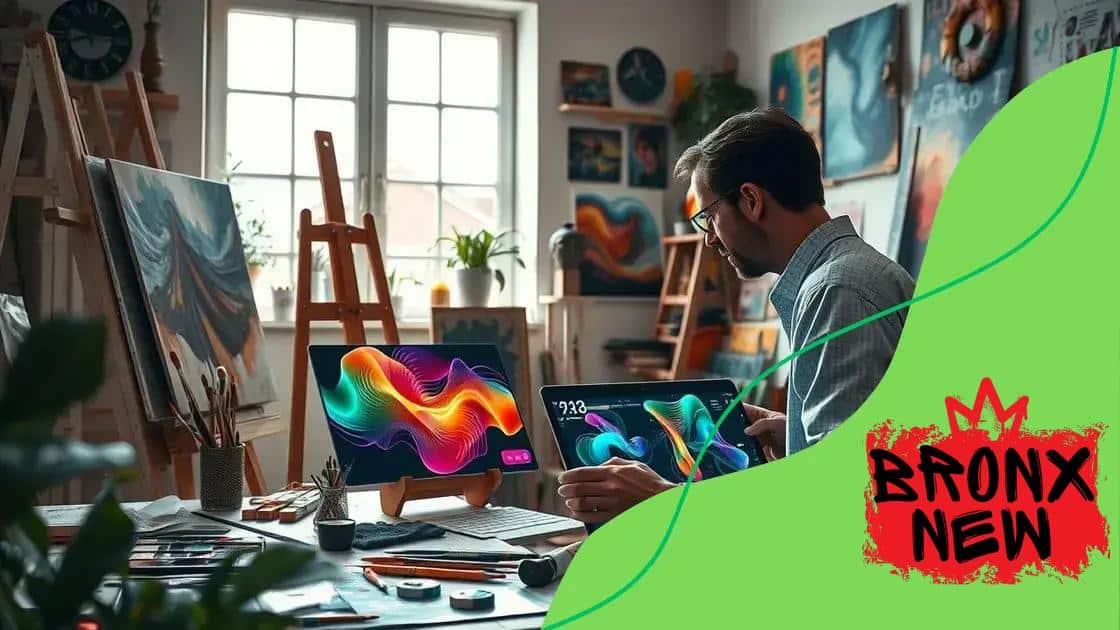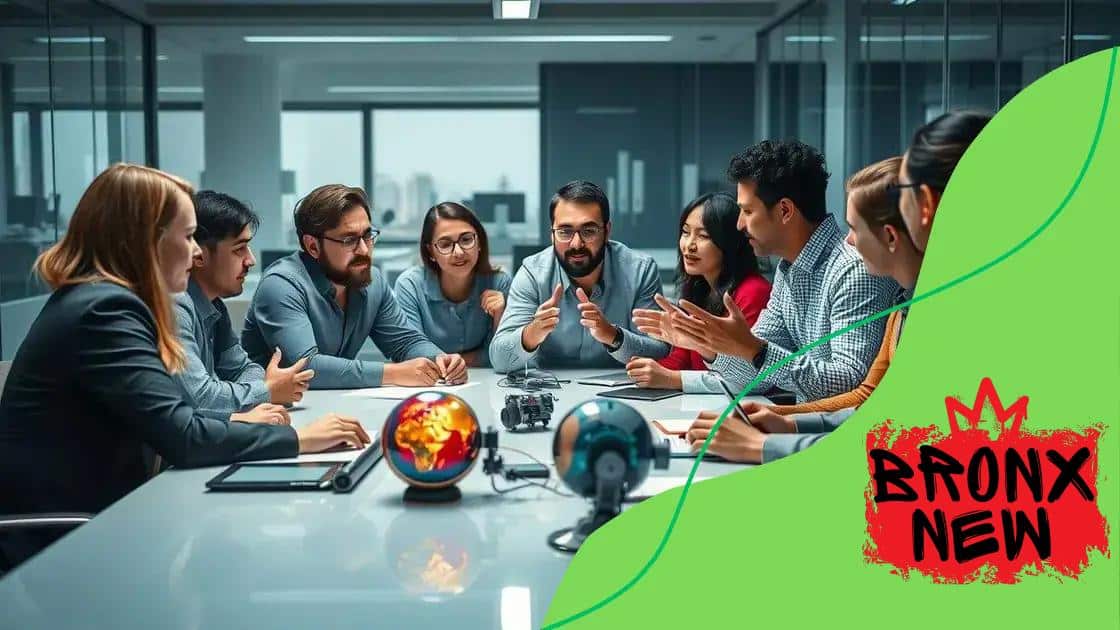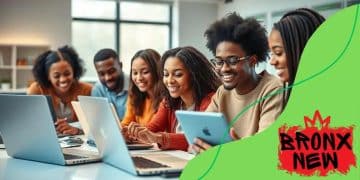The role of AI in transforming the creative industries

Adapting to AI innovations in the arts involves continuous learning, experimenting with AI tools, and networking with other artists to enhance creativity and embrace new opportunities.
The role of AI in transforming the creative industries invites us to rethink our creative processes. What if technology could enhance our artistic expression? Let’s explore how AI is reshaping the landscape.
Understanding AI’s impact on creativity
Understanding AI’s impact on creativity is essential in today’s evolving artistic landscape. AI technology is changing how artists approach their craft, leading to novel opportunities and challenges.
Enhancing Artistic Processes
AI tools can enhance the creative process in various ways. Programs like deep learning algorithms can analyze existing artworks and generate new concepts, providing unique ideas to artists.
- AI can assist in generating music by combining different styles.
- Visual artists can utilize AI to create realistic backgrounds.
- Writers can leverage AI for plot development and character creation.
These advantages show that AI isn’t just a replacement; it can be a collaborative partner that empowers creativity.
Collaboration with AI
Artists are increasingly collaborating with AI systems, leading to innovative art forms. For example, interactive installations use AI to adapt art based on audience reactions, making experiences more immersive.
Such collaborations encourage artists to explore and stretch their creative boundaries. It opens up a dialogue between humans and machines, resulting in artwork that resonates on multiple levels.
Challenges of AI in Creativity
Despite its benefits, there are challenges to consider. Artists may feel that their unique voice is compromised when AI systems influence their work. Questions about authorship and authenticity arise as AI-generated art gains popularity.
- Concerns about copyright issues are prevalent.
- Artists may worry about job displacement due to AI.
- Maintaining originality becomes a crucial debate.
These challenges signal the need for ongoing conversation about the balance between human creativity and technological advancement.
As we navigate this landscape, it’s clear that understanding AI’s impact on creativity is crucial. It invites rich discussions about future possibilities, ensuring that artistic expression continues to thrive alongside advancing technology.
Case studies of successful AI integration
Case studies of successful AI integration provide insights into how different industries are using technology creatively. Learning from these real-life examples can inspire artists and creators to explore new possibilities.
Music Industry Innovations
One notable example is in the music industry, where AI tools are transforming how music is composed and produced. Programs like OpenAI’s MuseNet can generate complex compositions in various styles, enabling musicians to experiment.
- AI has been used to create original soundtracks for films.
- Collaboration between AI and artists is resulting in unique musical experiences.
- Song analytics powered by AI help identify trends in listener preferences.
By integrating AI, musicians are not only enhancing their creative process but also reaching wider audiences.
Visual Arts and AI
In the realm of visual arts, AI’s impact is equally profound. One example is the use of AI-driven applications like DeepArt that transform photos into artwork styled after famous painters. This enables artists to quickly visualize concepts and styles.
Furthermore, AI can analyze existing artworks for style matching, helping artists find inspiration for their next piece. The combination of human creativity with AI technology leads to fresh artistic expressions that often captivate audiences.
Fashion Industry Applications
The fashion industry is also witnessing significant changes through AI. Brands use AI to predict fashion trends and optimize inventory, ensuring that they meet customer demands efficiently. For instance, AI algorithms analyze social media data to gauge emerging style preferences.
- Designers can create collections based on analyzed data.
- AI-powered chatbots enhance customer service and engagement.
- Virtual fitting rooms powered by AI allow customers to try on clothes online.
These applications streamline the creative process and improve customer experience, illustrating AI’s versatility across industries.
As seen in these case studies, successful AI integration not only enhances creativity but also opens new avenues for artistic expression. Artists can draw inspiration from these examples, encouraging them to embrace technology for their creative journeys.
Challenges faced by creative professionals

Challenges faced by creative professionals are growing as technology evolves. In a world increasingly influenced by artificial intelligence, artists must navigate new landscapes while maintaining their unique voice.
Impact of AI on Originality
One major concern is the impact of AI on originality. As AI-generated works become more common, artists worry that their unique styles may become diluted. The line between human and machine-created art can blur, leading to questions about what constitutes true creativity.
- Artists may face pressure to adapt their styles to remain relevant.
- There are concerns about how AI might simplify complex creative processes.
- Maintaining a personal touch in an era dominated by machine-generated content is increasingly challenging.
This struggle highlights the importance of guarding personal expression amidst advancing technology.
Job Security in the Age of Automation
Another pressing issue is job security. As AI tools become more capable, creative professionals may feel threatened by the prospect of being replaced. This fear isn’t unfounded; companies might choose AI-generated content for efficiency and cost-effectiveness.
Despite this, many argue that AI should enhance rather than replace human creativity. By using AI as a tool, artists can focus more on the creative aspects of their work while letting technology handle repetitive tasks.
Economic Pressures
Economic pressures also play a significant role in creative fields. Funding for the arts can be inconsistent, and creatives often struggle to find stable income sources. Additionally, the rapid pace of technological change means that professionals must continually learn new skills to stay relevant.
- Creative professionals may need to invest in their education to adapt to new technologies.
- Many are juggling multiple jobs to sustain themselves financially.
- Undervaluation of creative work can lead to burnout and dissatisfaction.
The combination of financial instability and constant evolution puts immense pressure on creatives to innovate while making a living.
As they face these challenges, it’s crucial for creative professionals to advocate for their roles and seek support from their communities. Understanding these issues is the first step towards fostering an environment where creativity can thrive, regardless of technological advancements.
Future trends in AI and creativity
Future trends in AI and creativity reveal exciting possibilities for artists and creators. As technology advances, the intersection of artificial intelligence and human creativity evolves, shaping new ways to express ideas.
AI-Driven Customization
One prominent trend is the rise of AI-driven customization. Tools that personalize content based on user preferences will become commonplace. This means artists can tailor their work to specific audiences, leading to more engaging experiences.
- Customized art can enhance user interaction.
- AI can analyze data to determine what styles resonate with different demographics.
- Artists can create dynamic pieces that change based on viewer input.
This level of customization allows creators to connect with their audiences in innovative ways.
Enhanced Collaboration between Humans and AI
The future will likely see even greater collaboration between humans and AI systems. Artists might view AI as a creative partner rather than just a tool. This collaborative spirit can lead to unique art forms and genres.
For instance, AI might suggest new techniques, generate variations of an artist’s work, or even help brainstorm ideas for projects. Such partnerships can push the boundaries of creativity and challenge traditional artistic methods.
Immersive Experiences with AI
Another exciting trend is the development of immersive experiences powered by AI. With advancements in virtual reality (VR) and augmented reality (AR), artists can create environments that respond to viewer actions.
- Virtual galleries can adapt to viewer interest, highlighting specific pieces.
- AR can bring static artworks to life, adding layers of interaction.
- Experiences could incorporate sound and motion, creating multisensory connections.
These immersive elements not only enhance engagement but also allow for deeper emotional connections to art.
As we look to the future, the integration of AI and creativity promises exciting developments. By harnessing these trends, artists will not only redefine their craft but also reshape how audiences perceive and interact with art.
How to adapt to AI innovations in arts
How to adapt to AI innovations in arts is crucial for creative professionals today. With technology rapidly changing, artists need to find ways to embrace these tools while keeping their unique voices.
Embrace Continuous Learning
One of the first steps in adapting is to embrace continuous learning. Creatives should seek out courses and workshops that focus on AI technologies and how they can be integrated into artistic practices. Understanding software and tools can lead to innovative techniques and processes.
- Look for online tutorials on AI art generation tools.
- Attend workshops that explore AI in music production.
- Participate in forums where artists discuss their experiences with AI.
This knowledge empowers artists to leverage technology rather than fear it.
Experiment with New Tools
Another important aspect is experimentation. Artists should try out new AI tools to discover what works for their creative process. Whether it’s using AI for image generation, music composition, or writing, hands-on experience can spark new ideas.
By exploring various tools, artists can push their boundaries and discover new styles and techniques. Over time, this experimentation can lead to a unique blend of human creativity and AI efficiency.
Network with Other Artists
Networking is also essential for adapting to innovations. Joining communities of artists who are exploring AI can provide valuable insights and support. Online platforms and local art groups can foster connections that inspire and motivate.
- Attend art exhibitions that focus on AI.
- Join social media groups dedicated to AI in the arts.
- Collaborate with other artists to explore AI possibilities together.
Such interactions can open doors to collaboration and the sharing of ideas that could lead to groundbreaking work.
Adapting to AI innovations in the arts requires a proactive approach. By focusing on learning, experimenting, and networking, artists can effectively navigate this new landscape and thrive in their creative endeavors.
In conclusion, adapting to AI innovations in the arts is essential for today’s creative professionals. By embracing continuous learning, experimenting with new tools, and networking with other artists, creatives can thrive in this changing landscape. AI should not be viewed as a threat but rather as a powerful tool that can enhance artistic expression and open up new opportunities. As artists navigate these changes, staying proactive and open-minded will be key to unlocking their potential in the evolving art world.
FAQ – Frequently Asked Questions about AI Innovations in Arts
How can artists stay updated with AI technology?
Artists can stay updated by attending workshops, taking online courses, and participating in forums focused on AI in the arts.
What are some AI tools that artists can experiment with?
Artists can experiment with AI tools like DeepArt for visual art, AIVA for music composition, and GPT-3 for creative writing.
Why is networking important for artists adapting to AI?
Networking allows artists to share experiences, learn from one another, and possibly collaborate on innovative projects that blend human creativity with AI.
How can AI enhance an artist’s creative process?
AI can suggest new ideas, help with repetitive tasks, and provide insights based on audience preferences, enhancing the overall creative process.





